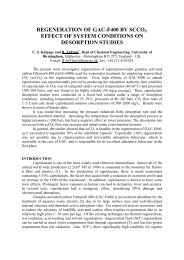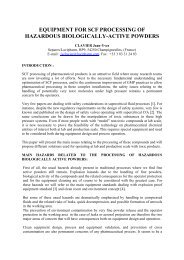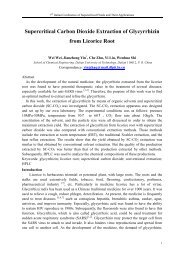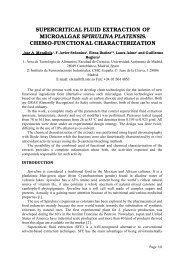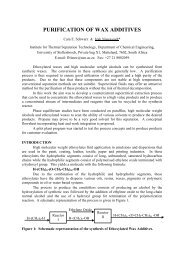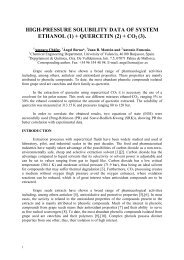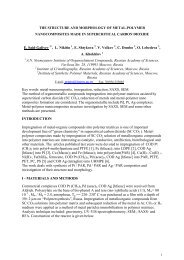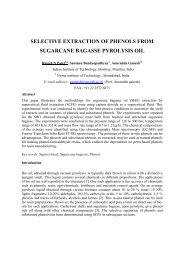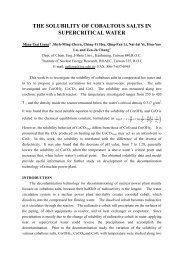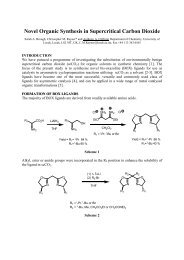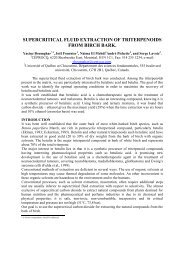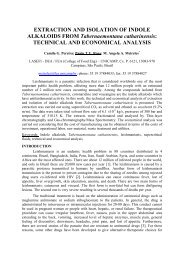continuous esterification in supercritical carbon dioxide - ISASF
continuous esterification in supercritical carbon dioxide - ISASF
continuous esterification in supercritical carbon dioxide - ISASF
Create successful ePaper yourself
Turn your PDF publications into a flip-book with our unique Google optimized e-Paper software.
an air oven and temperature was ma<strong>in</strong>ta<strong>in</strong>ed with<strong>in</strong> ±1 o C us<strong>in</strong>g a thermocouple controller<br />
device (Alton Ray Co., model TC14, Tehran. Iran).<br />
All experiments were performed at equilibrium and saturation conditions [7]. The<br />
liquid <strong>carbon</strong> <strong>dioxide</strong> was pressurized, by a JASCO model PU-980 reciprocat<strong>in</strong>g pump<br />
through a preheat<strong>in</strong>g coil <strong>in</strong> the oven, that enable CO 2 to reach oven temperature before<br />
enter<strong>in</strong>g the equilibrium cell. At the beg<strong>in</strong>n<strong>in</strong>g of each experiment, the system was ma<strong>in</strong>ta<strong>in</strong>ed<br />
at the desired temperature and pressure for at least 30 m<strong>in</strong>. The saturated SC-CO 2 passes<br />
through the catalytic bed, where chemical reactions take place and SC-CO 2 along with<br />
products and unreacted substrates was depressurized through a back-pressure regulator<br />
(JASCO, BP 1580-81). After the trap, the flow rate of expanded CO 2 gas was measured with<br />
wet gas meter (model W-NK-18, Sh<strong>in</strong>agawa, Japan). In all experiments Amberlyst 15 was<br />
used as catalyst. It was dried to constant weight before use <strong>in</strong> an air oven at 90 o C.<br />
(iii) Analytical Methods. In this work a modified trap as shown <strong>in</strong> Figure 1 was designed<br />
and used. The ma<strong>in</strong> parts of collection are a cool<strong>in</strong>g coil and a condenser. The coolant liquid<br />
(ethylene glycol) was circulated (LAUDA E104) <strong>in</strong> a coil. The coil and the collection vial (a<br />
two neck 5 mL flask) were submerged <strong>in</strong>to a 250 mL beaker that was filled with ethylene<br />
glycol, and the coolant was circulated around the condenser. The temperature of collection<br />
vial was –8 to –10 o C and the condenser temperature was set at -12 o C.<br />
The trapped mixture was transferred <strong>in</strong>to a volumetric flask and after addition of 1 mL<br />
1-hexanol, as an <strong>in</strong>ternal standard, the volume were made to 5 mL with n-hexane. The<br />
samples were analyzed with GC-TCD with a packed SE-30 column (Shimadzu Co. model<br />
GC-14A) us<strong>in</strong>g a temperature programm<strong>in</strong>g as follows: The <strong>in</strong>jection port and the detector<br />
temperature of GC were set at 240 o C and 250 o C respectively. The column temperature was<br />
programmed as zero m<strong>in</strong>. at 50 o C, 0 m<strong>in</strong> at 90 o C, and 10 m<strong>in</strong> at 240 o C with the temperature<br />
ramp of 6 o C. m<strong>in</strong> -1 and 40 o C .m<strong>in</strong> -1 , respectively.<br />
2E2E and 2EHE were determ<strong>in</strong>ed by external calibration and alkene was determ<strong>in</strong>ed<br />
based on mass balance of <strong>in</strong>itial mole of 2-ethyl-1-hexanol. The yield of 2E2E was calculated<br />
based on number of reacted moles of 2-ethyl hexanoic acid. The yields of 2EHE and alkene<br />
were calculated based on <strong>in</strong>itial mole of 2-ethyl-1-hexanol.<br />
Results and Discussions<br />
In our previous works [8] it was shown that the solubility of 2-ethyl-1-hexanol and 2-<br />
ethyl hexanoic acid <strong>in</strong> SC-CO 2 , for a 1:1 molar ratio of alcohol to acid <strong>in</strong> the equilibrium cell,<br />
were similar. This co-solubility may be due to the existence of <strong>in</strong>termolecular hydrogen<br />
bond<strong>in</strong>g between molecules of 2-ethyl-1-hexanol and 2-ethyl hexanoic acid. Moreover similar<br />
solubility was ma<strong>in</strong>ta<strong>in</strong>ed versus time [7].<br />
In this work the concept of co-solubility was used to perform chemical reaction <strong>in</strong> SC-<br />
CO 2 . The SC-CO 2 dissolves 2-ethyl-1-hexanol and 2-ethyl hexanoic acid and then passes<br />
through the heterogeneous catalyst where dehydration, etherification and <strong>esterification</strong><br />
reactions may take place.<br />
The effect of the temperature on product yield is shown <strong>in</strong> Table 1. Rais<strong>in</strong>g the<br />
temperature from 75 to 110 o C <strong>in</strong>creases the conversion and the product yields. With further<br />
<strong>in</strong>crease <strong>in</strong> temperature from 110 to 140 o C a significant reduction <strong>in</strong> conversion of alcohol<br />
and acid to ester takes place. That might be due to catalyst deactivation [2] or desulfonation.<br />
The effect of pressure on the <strong>esterification</strong> was also studied <strong>in</strong> the pressure range of<br />
150 to 250 bar (Table 2). At higher pressures the solubility of 2-ethyl-1-hexanol and 2-ethyl<br />
hexanoic acid and the residence time over the catalyst are <strong>in</strong>creased [2]. The yield of<br />
<strong>esterification</strong> reaction is approximately constant and <strong>in</strong>dependent of pressure. This behavior<br />
2



